Winter weather is a significant contributor to injuries and death in auto accidents. Days are shorter, so more driving occurs in the dark, and lower temperatures turn rain to sleet, snow and ice and make roads more slippery and hazardous. Heavy snow and sleet also can reduce visibility.
Common Accidents in Winter Weather Conditions
The likelihood of a serious car accident in NYC is far higher during the winter months. Accidents at intersections are more likely, as well as collisions from vehicles that are sliding out of control on streets and highways. The impacts can be head on, side impact or rear end accidents, all of which are extremely dangerous for drivers and passengers.
Out-of-control commercial trucks pose a much higher risk to drivers in New York during the winter months, with a higher number of jackknife accidents, as well as other types of weather related collisions.
Winter Driving Statistics
Below are some facts and statistics about winter driving and car accidents to keep in mind as the weather turns colder in the weeks ahead:
Over 70 percent of the nation’s roads are located in snowy regions, which are defined as receiving more than five inches average snowfall annually. Nearly 70 percent of the U.S. population lives in a snowy region of the country. (Federal Highway Administration)
New York City’s Central Park had 57.4 inches of snow in the winter of 2013-14 (National Weather Service)
Each year, 24 percent of weather-related vehicle crashes occur on snowy, slushy or icy pavement and 15 percent happen during snowfall or sleet. (Federal Highway Administration)
Nearly 20 percent more car accidents in which a pedestrian is killed or seriously injured occur each month in New York City during the November/December winter holiday season, as compared to the monthly average for the rest of the year. Possible explanations for this include increased evening shopping activity, higher pedestrian and vehicle volumes, increased holiday alcohol use and poor winter road conditions. (New York City Pedestrian Safety Study & Action Plan)
Over 1,300 people are killed and more than 116,800 people are injured in vehicle crashes on snowy, slushy or icy pavement annually. (Federal Highway Administration)
Every year, nearly 900 people are killed and nearly 76,000 people are injured in vehicle crashes during snowfall or sleet. (Federal Highway Administration)
Because drivers are more careful in snow, snow days have fewer fatal crashes than dry days, but more nonfatal-injury crashes and property-damage-only crashes. (American Journal of Public Health, Highway Safety Research Center, University of North Carolina, Chapel Hill)
Out of the 25 days of the year averaging the most deaths on the nation’s roads from 2007 to 2011, only one was in the winter: January 1. But of the 25 days of the year with the fewest driving deaths, 23 were in the winter. Why? Far fewer miles are driven in the winter. (Insurance Institute for Highway Safety via NBC News)
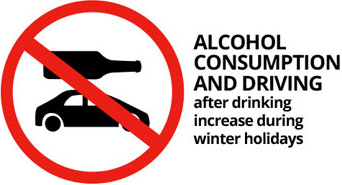
The Holidays: Alcohol and Vehicle Accidents
The winter months are also time for celebration, with many parties and family get-togethers that extend from Thanksgiving through to New Years. With icy, snowy or slick roads, the added element of alcohol consumption makes winter driving even more dangerous during the holiday season.
During Christmas holidays in 2012 (December 21 through 26), 134 people died in drunk driving crashes. This represents 37 percent of traffic deaths, compared with 31 percent on average for the year. Over the New Year holiday (6 p.m. on December 30 to 6 a.m. January 3), 140 people were killed in drunk driving crashes, which is 39 percent of the total people killed in traffic crashes. (Mothers Against Drunk Driving)
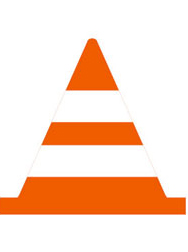
As you can see, there are a lot of ways to be injured in an accident in the winter months in New York, particularly when the sidewalks and roads are covered with ice or slush. If the carelessness or negligence of another driver caused a serious accident, you may be entitled to seek compensation to cover your medical bills and other expenses.
NYC Winter Driving Tips
When motorists ignore the effects of freezing rain and snow and drive too fast for the road conditions, they put everyone outside at risk of an accident. Icy road conditions can cause fender benders, rear end collisions, and more serious accidents leading to severe and fatal injuries.
Here are some ways to stay safe while on the road in NYC during the winter months.
Remain Extra Alert to Anticipate and Avoid Icy Road Accidents
Motorists need to use extra caution when driving in winter conditions and try to anticipate dangerous situations to avoid them. If freezing rain has recently begun falling, the roads may not be salted. The dangers of winter driving include hazards that are obvious as well as those that are difficult to see.
Black Ice: This hazard is caused when the air temperature reaches 32 degrees at or below the ground and rain starts to fall and freeze on contact, creating a sheet of ice. Black ice is hard to see because it is clear and blends with the pavement.
Ice and snow: Ice sets up, causing motorists to slip and slide, when the surface temperature on wet roads dips below the freezing point. Because the ground turns warm slower than air, ice can be on roads even when the temperature is above freezing.
How to Avoid Accidents on Icy Roads
Follow these New York winter driving recommendations from the American Automobile Club:
-
Check your tires for proper inflation and don’t buy into the myth that you drive more safely on under inflated tires.
-
Don’t mix radial tires with other types of tires.
-
Drive slower than normal because coming to a stop on snowy roads takes longer than on dry pavement.
-
Increase your following distance from four seconds to eight or 10 seconds to give yourself time to stop behind other vehicles.
-
Maintaining forward momentum is important on snow covered roads. Avoid stopping to the extent possible, particularly on hills. Try to time driving so you can roll through intersections when the light turns green.
-
Keep at least a half tank of gas to keep condensation from forming and freezing in the fuel line.
-
If you start to slide on ice, turn the wheel in the direction you want the vehicle to go.
-
Don’t try to overpower hills because giving your car too much gas makes the wheels spin. Use momentum to carry you up the hill, then reduce your speed at the top and proceed carefully down the other side.
Be alert for black ice and check thermometers outside to be prepared for the possibility of sheets of ice. Black ice almost eliminates traction, so the best rule when you hit a sheet is to remain calm and let the car pass over it, accuweather.com reports.
Prepare For Long Distance Trips
-
-
Check weather reports and delay trips when snow and ice storms are predicted.
-
-
Winter driving requires more energy and alertness than normal so get plenty of rest before a long distance drive.
-
Keep a cell phone on hand for emergencies and pack your vehicle with supplies such as blankets, gloves, hats, food, water, medication, and some cat litter, which could give your vehicle traction to get out of a ditch.
-
Stay with your vehicle in case you get snowbound. It will give you shelter and help rescuers find you.
-
Tie a bright cloth to the antenna as a distress signal and turn on your dome light if it’s nighttime.
-
Keep your exhaust pipe clear of snow, ice, and mud.
If necessary, run the engine long enough to keep the vehicle warm but don’t burn all your gas.
If possible, stay home during winter storms. Many people can work on computers and get plenty of office chores done without taking a risky drive to their place of business.
Speak to a Lawyer at HKD if You’re Injured
If you are injured in a car accident caused by another driver, discuss your legal options with a New York car accident lawyer.


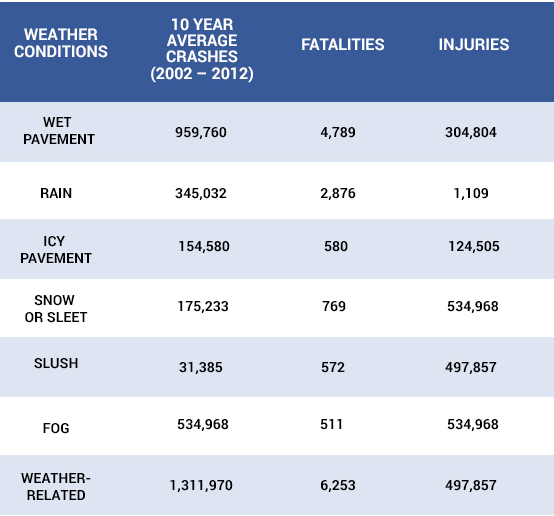
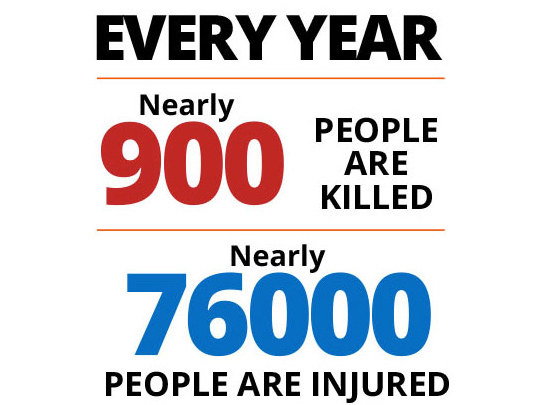
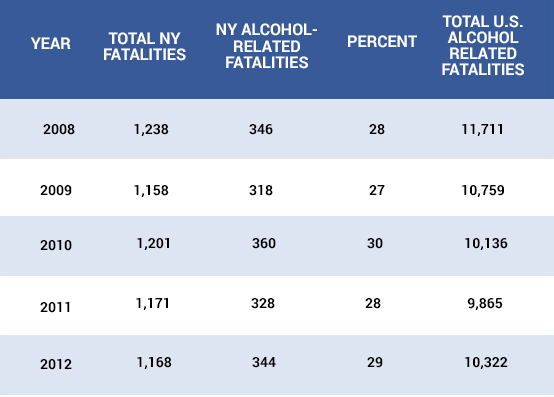
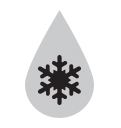 Black Ice: This hazard is caused when the air temperature reaches 32 degrees at or below the ground and rain starts to fall and freeze on contact, creating a sheet of ice. Black ice is hard to see because it is clear and blends with the pavement.
Black Ice: This hazard is caused when the air temperature reaches 32 degrees at or below the ground and rain starts to fall and freeze on contact, creating a sheet of ice. Black ice is hard to see because it is clear and blends with the pavement. Ice and snow: Ice sets up, causing motorists to slip and slide, when the surface temperature on wet roads dips below the freezing point. Because the ground turns warm slower than air, ice can be on roads even when the temperature is above freezing.
Ice and snow: Ice sets up, causing motorists to slip and slide, when the surface temperature on wet roads dips below the freezing point. Because the ground turns warm slower than air, ice can be on roads even when the temperature is above freezing. Check your tires for proper inflation and don’t buy into the myth that you drive more safely on under inflated tires.
Check your tires for proper inflation and don’t buy into the myth that you drive more safely on under inflated tires. Don’t mix radial tires with other types of tires.
Don’t mix radial tires with other types of tires. Drive slower than normal because coming to a stop on snowy roads takes longer than on dry pavement.
Drive slower than normal because coming to a stop on snowy roads takes longer than on dry pavement. Increase your following distance from four seconds to eight or 10 seconds to give yourself time to stop behind other vehicles.
Increase your following distance from four seconds to eight or 10 seconds to give yourself time to stop behind other vehicles. Maintaining forward momentum is important on snow covered roads. Avoid stopping to the extent possible, particularly on hills. Try to time driving so you can roll through intersections when the light turns green.
Maintaining forward momentum is important on snow covered roads. Avoid stopping to the extent possible, particularly on hills. Try to time driving so you can roll through intersections when the light turns green. Keep at least a half tank of gas to keep condensation from forming and freezing in the fuel line.
Keep at least a half tank of gas to keep condensation from forming and freezing in the fuel line. If you start to slide on ice, turn the wheel in the direction you want the vehicle to go.
If you start to slide on ice, turn the wheel in the direction you want the vehicle to go. Don’t try to overpower hills because giving your car too much gas makes the wheels spin. Use momentum to carry you up the hill, then reduce your speed at the top and proceed carefully down the other side.
Don’t try to overpower hills because giving your car too much gas makes the wheels spin. Use momentum to carry you up the hill, then reduce your speed at the top and proceed carefully down the other side. Be alert for black ice and check thermometers outside to be prepared for the possibility of sheets of ice. Black ice almost eliminates traction, so the best rule when you hit a sheet is to remain calm and let the car pass over it, accuweather.com reports.
Be alert for black ice and check thermometers outside to be prepared for the possibility of sheets of ice. Black ice almost eliminates traction, so the best rule when you hit a sheet is to remain calm and let the car pass over it, accuweather.com reports. Check weather reports and delay trips when snow and ice storms are predicted.
Check weather reports and delay trips when snow and ice storms are predicted. Winter driving requires more energy and alertness than normal so get plenty of rest before a long distance drive.
Winter driving requires more energy and alertness than normal so get plenty of rest before a long distance drive. Keep a cell phone on hand for emergencies and pack your vehicle with supplies such as blankets, gloves, hats, food, water, medication, and some cat litter, which could give your vehicle traction to get out of a ditch.
Keep a cell phone on hand for emergencies and pack your vehicle with supplies such as blankets, gloves, hats, food, water, medication, and some cat litter, which could give your vehicle traction to get out of a ditch. Stay with your vehicle in case you get snowbound. It will give you shelter and help rescuers find you.
Stay with your vehicle in case you get snowbound. It will give you shelter and help rescuers find you. Tie a bright cloth to the antenna as a distress signal and turn on your dome light if it’s nighttime.
Tie a bright cloth to the antenna as a distress signal and turn on your dome light if it’s nighttime. Keep your exhaust pipe clear of snow, ice, and mud.
Keep your exhaust pipe clear of snow, ice, and mud. If necessary, run the engine long enough to keep the vehicle warm but don’t burn all your gas.
If necessary, run the engine long enough to keep the vehicle warm but don’t burn all your gas.